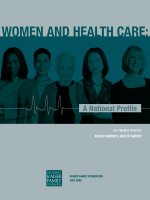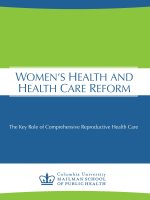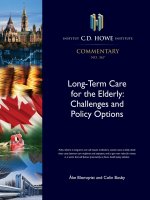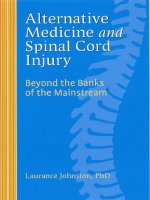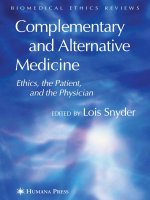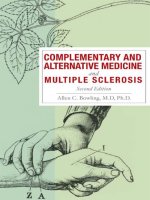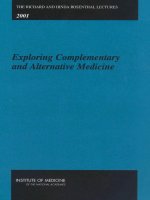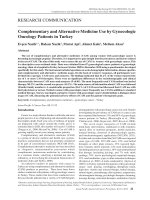Traditional, Complementary and Alternative Medicine and Cancer Care pptx
Bạn đang xem bản rút gọn của tài liệu. Xem và tải ngay bản đầy đủ của tài liệu tại đây (893.74 KB, 192 trang )
Traditional, Complementary
and Alternative Medicine
and Cancer Care
Over the last decade, traditional, complementary and alternative medicine has
achieved an ever-higher profile amongst academics, healthcare professionals, policy
makers and service users, particularly in cancer care. Despite anecdotal evidence of the
importance of patient groups and grassroots networks to the way people access thera-
pies, research has tended to focus on the individual.
Traditional, Complementary and Alternative Medicine and Cancer Care provides
the first in-depth exploration of the role patient support groups play in the provision
of CAM in the UK and Australia. It also looks at the utilisation of non-biomedical
treatments in Pakistan focusing on the role of informal social networks.
Drawing on fieldwork in each country, the book explores:
●
the empirical, theoretical and policy context for the study of CAM/TM and
cancer
●
the nature, structure and evolution of patient support groups
●
how groups function on a day-to-day basis
●
the extent to which what is being offered in these CAM-oriented groups is in
any way innovative and challenging to the therapeutic and organisational
mainstream
●
the ways in which processes of negotiating therapeutic options play out in
Pakistan.
Traditional, Complementary and Alternative Medicine and Cancer Care will be of
wide interest to those studying complementary and alternative medicine sociologi-
cally, to those involved in the provision of cancer care on a day-to-day basis and to
those looking to establish a more informed, evidence-based policy.
Philip Tovey is a Reader in Health Sociology at the School of Healthcare, University
of Leeds, UK.
John Chatwin is a Research Fellow at the School of Healthcare, University of
Leeds, UK.
Alex Broom is a Postdoctoral Research Fellow in the School of Social Science at the
University of Queensland, Australia.
An international analysis of
grassroots integration
Philip Tovey, John Chatwin
and Alex Broom
Traditional,
Complementary and
Alternative Medicine
and Cancer Care
First published 2007
by Routledge
2 Park Square, Milton Park, Abingdon, Oxon OX14 4RN
Simultaneously published in the USA and Canada
by Routledge
270 Madison Avenue, New York, NY 10016
Routledge is an imprint of the Taylor & Francis Group, an informa business
© 2007 Philip Tovey, John Chatwin and Alex Broom
All rights reserved. No part of this book may be reprinted or reproduced
or utilised in any form or by any electronic, mechanical, or other means,
now known or hereafter invented, including photocopying and recording,
or in any information storage or retrieval system, without permission in
writing from the publishers.
British Library Cataloguing in Publication Data
A catalogue record for this book is available from the British Library
Library of Congress Cataloging in Publication Data
Tovey, Philip, 1963-
Traditional, complementary, and alternative medicine and cancer care : an
international analysis of grassroots integration / Philip Tovey, John
Chatwin, and Alex Broom.
p. ; cm.
Includes bibliographical references and index.
1. Cancer Alternative treatment Cross-cultural studies.
I. Chatwin, John. II. Broom,Alex. III.Title. [DNLM: 1. Complementary
Therapies Australia. 2. Complementary Therapies Great Britain. 3.
Complementary Therapies Pakistan. 4. Neoplasms therapy Australia.
5. Neoplasms therapy Great Britain. 6. Neoplasms therapy Pakistan. 7.
Cross-Cultural Comparison Australia. 8. Cross-Cultural Comparison
Great Britain. 9. Cross-Cultural Comparison Pakistan. 10. Self-Help
Groups Australia. 11. Self-Help Groups Great Britain. 12. Self-Help
Groups Pakistan. QZ 266 T736t 2007]
RC271.A62T7344 2007
362.196'994 dc22
2006029003
ISBN 10: 0-415-35993-7 (hbk) ISBN 13: 978-0-415-35993-1 (hbk)
ISBN 10: 0-415-35994-5 (pbk) ISBN 13: 978-0-415-35994-8 (pbk)
ISBN 10: 0-203-00794-8 (ebk) ISBN 13: 978-0-203-00794-5 (ebk)
This edition published in the Taylor & Francis e-Library, 2007.
“To purchase your own copy of this or any of Taylor & Francis or Routledge’s
collection of thousands of eBooks please go to www.eBookstore.tandf.co.uk.”
ISBN 0–203–00794–8 Master e-book ISBN
For
W. Talist (as always); Betty and Charles
Brian and Alison
List of illustrations ix
Acknowledgements x
List of abbreviations xi
Introduction 1
PART I 9
1 The empirical, theoretical and policy context in
international perspective 11
2 Methodology: an overview of approach and
research sites in the UK, Australia and Pakistan 32
PART 2 47
3 The nature of CAM-focused cancer support groups 49
4 Group performance: enacting therapeutic alternatives
in the collective environment 65
5 Confined innovation: organisational challenge and
its limitations 81
6 An exploratory comparative case study from
Australia 100
Contents
PART 3 115
7 Consumption, and perceptions, of traditional,
complementary and biomedical cancer treatments
in Pakistan 117
8 Patients’ negotiation of therapeutic options 130
9 Interprofessional conflict and strategic alliance 144
Conclusion 158
Notes 168
Bibliography 170
Index 178
viii Contents
Figures
1.1 Use of traditional medicine for primary healthcare 27
4.1 Layout of the group area 69
6.1 The meditation room 107
8.1 Cancer patients’ negotiation of therapeutic options in
Pakistan 134
Tables
1.1 Categories of CAM: National Centre for
Complementary and Alternative Medicine (US) 12
7.1 CAM/TM use and level of education 123
7.2 Use of a Hakeem and level of education 123
7.3 Total CAM/TM use by hospital 124
7.4 Socio-economic status by hospital 124
7.5 Perceptions of the effectiveness of TM, CAM and
biomedical cancer treatments 125
7.6 Satisfaction with CAM/TM and biomedical
cancer treatments 126
Illustrations
The projects on which this book is based were unusually complex to con-
duct and a number of people provided invaluable input. Thanks are due to
Muhammad Hafeez, Salma Ahmad and Shahin Rashid for their contribu-
tion to the work in Pakistan, and to Jon Adams for his involvement in
Australia. Thanks are also given to the many people in the UK fieldwork
sites who supported the work but who need to remain anonymous; and, of
course, we are grateful to the significant number of individual participants
in each of the countries. The work was funded by two grants from the
Economic and Social Research Council/Medical Research Council under
their Innovative Health Technologies programme.
Finally, many thanks to Kathryn Dewison for reading the final manu-
script – bhgaft.
Acknowledgements
CAM Complementary and alternative medicine
CRUK Cancer Research United Kingdom
DoH Department of Health (UK)
ESRC Economic and Social Research Council (UK)
NHMRC National Health and Medical Research Council (AUS)
NHS National Health Service (UK)
RCCM Research Council for Complementary Medicine (UK)
TCM Traditional Chinese medicine
TM Traditional medicine
WHO World Health Organization
List of abbreviations
The use of non-biomedical therapeutics and the management of cancer are
high profile issues in health internationally. They both generate, in their
own right, considerable debate amongst academics, practitioners and the
wider public. Increasingly, as non-biomedical approaches have become
more and more a feature of the range of therapeutic options available to
cancer patients, the two have become inextricably linked. This book is con-
cerned with that increasingly evident combination. Specifically, it is a
socially located analysis of previously under-researched aspects of this com-
ing together in both richer and poorer countries – namely, the UK, Australia
and Pakistan.
The book is written at a time of considerable change. In richer countries
the entrenched oppositional positions of less than a decade ago are being
replaced by a (largely) rhetorical consensus on integration. For many in
policy-making arenas the virtues of this trend have achieved an almost
taken-for-granted quality in a short space of time. At a global level a seem-
ingly positive shift in attitudes towards the promotion of traditional
medicine (TM) as a means of satisfying unmet health need (WHO 2001),
and the theoretical possibility of the spread of non-indigenous practices to
poorer countries have also established a dynamic of change.
Given these significant and fast-moving shifts in the use of non-biomedical
medicines for cancer care it is not surprising that research in the area is at a
relatively early stage. While this paucity of research is beginning to be
addressed in richer countries (e.g. Bishop and Yardley 2004; Cassileth and
Vickers 2005; Ernst and Cassileth 1998; Lewith et al. 2002; McClean 2005;
Morris et al. 2000; Rees et al. 2000), beyond the West, research has been min-
imal. However, as the need for research has become increasingly recognised
(House of Lords 2000), two inter-related elements have informed that push:
first, the necessity of evidence on the effectiveness and efficacy (as well as
safety) of specific practices; and second, the need for ‘results’ that will
inevitably and immediately lead to policy development and practice change.
When researching and writing on any issue within the broad field of
‘health’ there is an understandable tendency to seek solutions: to fast-track
Introduction
the process of gathering information in order to argue a case for change at
whichever level. This is, of course, not specific to health. However, the
issues presented by people’s suffering, by the persistence of an unequal
access to resources which have an immediate and apparent consequence in
terms of day-to-day wellbeing, and indeed survival itself, make the pursuit
of policy as the logical outcome of each and every study all the more
understandable.
And when the health topic in question is cancer, with all its symbolic,
and indeed, physical and practical importance and impact, the need to work
towards better patient outcome becomes all the more pressing. In the West
the expansion of use of non-biomedical approaches has occurred largely in
the absence of a biomedical-type evidence base and in a socio-political con-
text of patchy and minimal regulation. In poorer countries, given the global
spread of biomedicine, other practices generally exist in a similar context.
There are certainly very real issues to address here, such as providing the
best available evidence about practices as a means of underpinning
informed choice by cancer patients.
However, having acknowledged this, it is crucial to appreciate that
there are dangers associated with the development of a narrow policy and
practice-driven research agenda. It is naïve to assume that the production
of evidence produces, in a simple, deterministic way, a given set of behav-
iours and decisions amongst practitioners or patients. This is something
that needs to be borne in mind across the board in an area as contentious
as non-biomedical practices. In the context of non-biomedical practices
for cancer, consideration of the multifaceted nature of evidence and legit-
imacy is absolutely imperative. Positions that have evolved in the absence
of an evidence base have been established on the basis of very powerful
influences: professional identity, differentiation and jurisdiction claims,
ideological affinities, divergent conceptualisations of the nature of disease
and so on.
Consequently, there is a need for a very different research agenda to be
pursued in tandem with the one rushing headlong towards evidence colla-
tion and yes/no policy judgements about the incorporation or isolation of
specific therapeutic practices. This is an agenda directed primarily at the
generation of an understanding of processes underpinning action. It is a
sociologically informed approach which takes its primary purpose to be
gaining insight into this social phenomenon as an end in itself. It is not that
such work may not, in time, inform health policy and practice; it is rather
that it need not be its primary and immediate goal. Indeed, the removal of
the ‘recommendations imperative’ will help to permit the production of
focused work which does not have to be spuriously stretched to reveal the
supposedly ‘generalisable’ on the basis of single pieces of work. It will allow
the gradual production of a more solid knowledge base which will make for
more effective policy making in the long term.
2 Introduction
It is against this background that the study(ies) which provide the basis
for this book were developed. The studies may justifiably be regarded as
either three separate studies conducted in different countries, or as compo-
nent parts of one broad enterprise. This is because while on the one hand,
there are inevitable points of conceptual linkage across the fieldwork sites,
on the other hand the specificity of context (as well as method and research
questions) makes direct comparison inappropriate. Indeed the analysis pre-
sented here should not be seen as comparative in any strict sense. Instead, it
should be seen as providing insights into the processes surrounding the util-
isation of non-biomedical practices for cancer care in specific locations.
Needless to say, especially when setting Pakistan alongside the UK or
Australia, the practices used differ greatly and the histories associated with
them are similarly disparate. Moreover, while conceptual linkage across
countries was manifest in our general interest in, for instance, decision mak-
ing or the role of advocates of non-biomedical practices, there were also
country-specific agendas which needed to be pursued – agendas which
necessitated the utilisation of, at times, differing methods, used to collate
different types of data.
Thus, the overall purpose of this work was to approach the study of the
global phenomenon of the utilisation of non-biomedical treatments for can-
cer from a fresh angle – to generate types of data and a form of
understanding that had not previously been established. There was no
attempt to conceptualise this as a means of generating a complete under-
standing of all aspects of the processes involved. Rather the aim was to
engage with country-specific issues in their own terms – issues which in
each nation had not been researched before.
In the UK (and Australia) our focus was on group-level action in grass-
roots patient support groups involved in the advocacy and/or provision of
complementary and alternative medicine (CAM) to people with cancer.
Born of a recognition that support groups incorporating some form of non-
biomedical therapies had proliferated in recent years, but that we had little
or no understanding of how they functioned in relation to the provision of
CAM, our focus here was on how such groups evolve and function and how
their location (frequently on the boundaries of orthodoxy) impinges on
those processes. Our approach was deliberately focused rather differently to
those studies that have generated data and interpretations of individual
CAM use in the West. It was an attempt to balance what has become,
arguably, an overly individualised approach to the topic.
In Pakistan, the research questions, though with some overlap, had a
very different quality. In part this was due to the inevitably very different
socio-cultural circumstances, but it was also influenced by the state of
knowledge prior to the study. In this context, although we were primarily
interested in how cancer patients negotiate the plurality of therapeutic
options available, there was also a need to establish some baseline data on
Introduction 3
patterns of use. Quite simply there was no previous qualitative work on this
topic (as well as virtually no quantitative data). While assumptions could be
made about the importance of ‘traditional practices’ or religion or a range
of other things, there was a need to explore these empirically to see if and
how such structures and processes were influencing action.
Despite these very real differences, conceptual linkages are evident across
the studies. In each case it is the socially located nature of action that is our
focus, and while being played out in very different ways, many core themes
– the relationship and interaction between biomedical practitioners and
non-biomedical practitioners or advocates, the role of evidence, the nature
of decision making, etc. – are seen to be cross-cutting themes of importance.
About the book
This book is then based around the findings of the international study intro-
duced above. The book is split into three parts. The purpose of Part 1 is to
provide an overview both of the area under study – the use of non-biomedical
approaches in the treatment of cancer – and to provide more of an insight into
the nature of what was an unusually complex study to conduct. As well as set-
ting up the main empirical parts of the book it is intended that the material
drawn together here will be of interest and use in its own right.
In Part 2 we present the findings from the part of the research conducted
in richer countries – primarily the UK, but also, as detailed in the final chap-
ter, Australia. It focuses directly on the structures and processes of cancer
support groups. Due to the nature of the study, this can both be read as a
stand-alone analysis of the nature of such groups in these countries and as
part of the broader whole.
Part 3 deals directly with the research conducted in Pakistan. Again these
chapters can be read as stand-alone analyses of various issues relating to the
mediation of therapeutic options in that country, although inevitably, there
are conceptual linkages with Part 2 which will become apparent.
More specifically, the book breaks down as follows. In Chapter 1 we
provide an overview of the empirical, theoretical, and where relevant, pol-
icy context for the study of CAM/TM and cancer. While inevitably we focus
particularly on those countries that form the core of the book (UK,
Australia and Pakistan), we also draw on work from elsewhere in the world
where this is relevant. During the discussion of Pakistan we include a profile
of the broader character of the country which sets out core elements of its
economic, social and religious profile. As will become apparent, an under-
standing of such contextual factors is essential to gaining insight into
health-related processes.
Given the conduct of fieldwork in three countries, and the utilisation of
different methods between the UK and Australia on the one hand and
Pakistan on the other, it is important to detail the approach taken and the
4 Introduction
elements of context that are specific to each country. This is the focus of
Chapter 2. In relation to the UK arm of the study, we pay particular atten-
tion to describing the history and character of the eight support groups in
which fieldwork took place. As will become evident, although they shared
some characteristics, they differed on quite important dimensions. For
example, they differed in their relationship with state-provided medical
institutions, which, it emerged, is crucially linked to the ways in which
CAM provision is operationalised. With the example of Australia, the
nature of the single case study is similarly described. For various reasons,
both practical and methodological, the approach taken to data collection
differed considerably in Pakistan. Given the need to establish a baseline
quantification of what was happening on the ground, a survey was con-
ducted before the core qualitative part of the study. The nature and purpose
of both parts of the work in Pakistan are explained.
Chapter 3 opens Part 2 and addresses some fundamental issues about the
nature, structure and evolution of patient support groups. Within a broader
discussion of the groups we argue that two important processes can be iden-
tified. First, that a useful differentiation can be made between Type 1 and
Type 2 groups. Although clearly an ideal type, this differentiation under-
lines not only the self-evident differences in history and affiliation of
groups, but, rather more interestingly, the influence that this exerts on the
evolution of those groups and the place of non-biomedical practices within
them. And, second, we outline how groups of both type follow similar pat-
terns of evolution and move through recognisably similar stages. Again, of
course, this conceptualisation allows for variation within broadly identifi-
able processes.
Having opened with a broad analysis of group form and character, in
Chapter 4 we focus on the detail of how groups function on a day-to-day
basis. We do this through the use of a case study of one particular site.
While not intending to present this case as ‘representative’ in any strict
sense, it does provide an interesting point of access into the kinds of issues
that have resonance beyond this individual group. The chapter is based
around an in-depth look at how a routine meeting of the group is enacted.
Amongst the key themes of the chapter are: the tensions that can arise
between location and the operationalisation of therapies, and secondly, the
role and impact of new members and the mediation of information. We thus
consider both structural and interactional elements of the group.
In the final chapter focusing solely on the UK, Chapter 5, attention is
turned to an examination of the extent to which what is being offered in
these CAM-oriented groups is in any way innovative, and indeed, challeng-
ing to the therapeutic and organisational ‘mainstream’. We examined this
issue because the rhetoric of difference, of providing and being something
distinct, is central to the raison d’etre of many such groups. We consider, in
turn, the nature of formal and informal gatekeeping and how this affects
Introduction 5
group composition; the actual organisation of the groups themselves; and
the extent to which groups offer challenge to broader inequalities. Central
to our analysis is a recognition of the ‘confined’ location (both therapeutic
and geographical) within which the groups evolve and function.
Part 2 of the book concludes with Chapter 6. In this chapter attention is
shifted to Australia. Here we present findings from a single exploratory case
study of a support group in New South Wales. Through an examination of
the regular patterns of the group we argue that, in order to identify the value
of the group to its participants, we not only need to look at its formal level of
operating but also its informal processes. By looking to this informal level, a
different mode of activity is identifiable – one which is in many ways freer,
due to the absence of the constraints that act on the coordinators of the
‘timetabled’ meetings. In this informal arena, the exchange of information
and ideas frequently takes on a more radical edge, a context which can be
seen as facilitating a fuller expression of the priorities of the members rather
than reflecting a political judgement on the appropriateness of practices.
Chapter 7 is the first of three chapters looking solely at the study data
generated in Pakistan. In order to establish the context for later discussions,
this chapter concentrates on the results of a survey conducted with cancer
patients in four hospitals in Lahore. Two findings in particular stand out
from this initial part of the work. First, that despite the theoretical possibil-
ity of the globalisation of non-indigenous CAMs, it was indigenous
traditional practices that figured heavily in the therapeutic practices of can-
cer patients. And second, that there is a need to recognise that traditional
medicine is not simply a monolithic category – patients make very different
judgements about different individual practices so classified. The latter find-
ing in particular is fundamental to the more detailed analysis of the
following chapter.
In that chapter – the eighth – we examine the accounts of cancer patients
in Pakistan, generated through one-to-one interviews, in order to work
towards an understanding of the actions and attitudes quantified earlier.
Specifically, we discuss the process of negotiating therapeutic options by
individual patients – but crucially we do so taking full account of their
social, cultural and material contexts. We argue that individuals are far
from simply and uncritically utilising what is traditional or local. Instead
they are actively mediating therapeutic possibilities by drawing on, and at
times being constrained by, personal, social and cultural resources. We
argue that this can be conceptualised by an appreciation of individuals’
active engagement with three temporally and spatially specific dimensions:
structural/practical constraint; pragmatic experimentation; and cultural
identity and religious affiliation.
The focus of Chapter 9 is on Pakistani cancer patients’ experiences of the
interprofessional dynamics associated with the range of traditional and bio-
medical cancer treatments. In this chapter we move away from patients’
6 Introduction
perceptions of particular treatment modalities, and towards an analysis of
their experiences of the dynamics between different therapeutic modalities. A
significant theme in this chapter is the apparent existence of considerable dif-
ferentiation in the dynamics between different traditional modalities and the
biomedical community. We examine the existence of strategic alignments
between certain traditional healers and the biomedical community, demon-
strating a complexity at the interface of TMs and biomedicine in Pakistan.
We argue here for the need for a multifaceted understanding of the social and
cultural processes underpinning the dynamics of these relationships.
We conclude with a chapter which summarises the key points of the
book and draws together its various component parts. We will identify
points at which it is useful to establish conceptual linkage between various
settings, although we argue that it is important to retain a sense of ‘differ-
ence’ and not impose any artificial unity on the processes described. In this
concluding section we also take the opportunity to return to a broader dis-
cussion of the value of sociological work in the field which is not tied to
immediate and narrow policy objectives. In this context we sketch out an
agenda of research priorities for the field.
Introduction 7
Part 1
